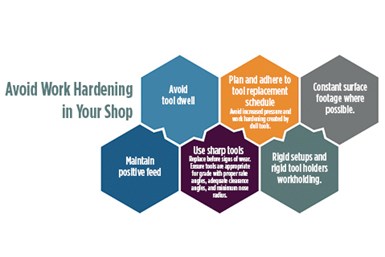Cold Work: Work Hardening and Your Precision Machining Shop
The pros and cons of cold work, work hardening.

Cold work is defined as the plastic deformation of a metal below its recrystallization temperature. At our suppliers this is done intentionally by cold drawing through a die or cold rolling. In our shops, cold working processes can include thread rolling, thread forming, swaging, crimping, staking, planishing, metal spinning and process failures such as unsharp tools, insufficient clearance, unstable setups and tool dwell.
Pros
Cold work (via process of cold drawing or cold rolling)
- Cold work improves the machinability of low carbon steels by increasing the strength and reducing the high ductility of the hot-rolled product. Cold working of the hot-rolled bar by die drawing or cold rolling increases the tensile and yield strength of the material, while lowering its ductility (reduction in area and % elongation). This change in properties results in chips that are harder, more brittle and curled, producing less built-up edge on the tool’s cutting edge. The improved yield to tensile ratio means that your tools and machines have less work to do to get the chip to separate. Steels between 0.15-0.30 wt.% carbon are best machining; above 0.30 wt.% the machinability decreases as carbon content (and hardness) increase.
- Cold work improves the surface finish attainable (up to a point). Cold drawn bars typically run 50 microinches max and usually arrive at 25-30 microinches in modern processes.
- Cold work holds dimensions and concentricity to a tighter tolerance. Cold work reduces the variability, so dimensions are able to be routinely held at plus 0.000" minus 0.002" or 0.003" for the low and medium carbon steels that we usually encounter.
- Cold work provides for straighter material. Cold drawn bars are held to straightness deviations as low as 1/16" in ten feet in standard mill runs, compared to the 1/4" max deviation in five feet that we can expect in a hot-rolled bar.
- Cold work improves your shop productivity (throughput) by improving machinability. The result of these advantages is that your cycle time is decreased, your need for secondary operations to remediate lousy surface finishes is eliminated and your process uptime and efficiencies increase. These all result in more parts and more conforming parts in the bin at the end of the shift.
These improvements in your operations justify the additional price you pay for a cold-drawn bar over a hot-rolled bar.
Cold work in your raw materials can be affected by your supplier’s drafting practice, availability of material to draw to your needed size, original melt and cast process, and chemistry. Both intentional additions and residuals can have an effect.
Standard draft or heavy draft can result in differences in hardness achieved and, thereby, reduction of the ductility that makes it difficult to separate the chip. Heavier draft makes the material more machinable, but may make subsequent cold working processes problematic, as we will discuss below.
Steels melted in Electric Furnace (EF or EAF) processes and cast into billets are generally found to be less ductile than those from Basic Oxygen Process (BOF or BOP) shops that are typically cast into larger bloom sections. The greater hot working reduction in the area of the larger section blooms provide more ductility in the as-rolled, hot-rolled bars.
Similarly, chemical differences reflecting these different process paths include higher nitrogen and residual elements in the EAF steels compared to BOF steels which are melted in an oxygen-saturated vessel with a lower percentage of scrap.
Cons
Work hardening can make the steel or the finished part that you produce unsuitable for further processing. Work hardening can make your in-process workpiece unmachinable, resulting in failed tools or destroyed setups, which can result in hours of downtime, lost production, missed shipments and higher cost per part.
What contributes to work hardening in our shops and how can we address it?
Cold work is plastic deformation of a metal below its recrystallization temperature.
Whenever a tool rubs or fails to cut, it creates a strain in the workpiece material under the tool. If the material is amenable to work hardening — its mechanical properties can change, altering the material’s response to the tool edge. Chips can become more problematic and increase built-up edge on the tool, as well as require even greater force to separate. The resulting chip can also become more abrasive and create greater wear on the tool.
In extreme cases, the cold work of the operation can exceed the ductility of the material and stress cracks can be the result.
What are some clues to suggest that work hardening could be an issue and you need to take special care with your process setup?
Nickel present as a specified ingredient. When you see nickel as a major ingredient in steel, avoid tool dwell and light cuts. Nickel contributes to a material’s work-hardening ability.
Nitrogen present as a specified (or implied) ingredient. Nitrogen can be intentionally added to boost mechanical properties (strength and hardness) as well as to improve surface finish. However, it can work against you if subsequent cold work is needed. Nitrogen is “implied” if the steel is produced by an electric furnace scrap-fed, steel-making process. Billet cast with lower rolling reductions can exacerbate this effect.
Nickel-based alloys, iron and cobalt-based alloys, titanium alloys. Each of these can severely work harden upon tool dwell or use of dull tools. Failure to have proper rake angles and or clearance angles can also impart cold work and, thus, work hardening. Minimize nose radii in these grades to minimize the chance for work hardening.
Read More Articles from PMPA:
- Welcome Tom Halladay, PMPA’s New Board President
-
Finishing Services that Remove or Reshape the Component Surface
About the Author
Miles Free III
Miles Free III is the PMPA Director of Industry Affairs with over 40 years of experience in the areas of manufacturing, quality, and steelmaking. He helps answer “How?, “With what?” and “Really?” Miles’ blog is at pmpaspeakingofprecision.com; email – mfree@pmpa.org; website – pmpa.org
Related Content
Craftsman Cribsheet No. 119: Defeating the Hanging Cross-Hole Burr
Deburring is a tedious task that is better left to machines.
Read MoreKeeping It In The Family — Succession Tips From Those Who Lived It | Part 1
PMPA members share some tips to avoid getting burned when passing the business torch from one family member to another.
Read MoreA No/Low-Cost Solution to Employee Retention
Studies show a little employee recognition goes a long way. Here are the 5Ws to consider for success.
Read MoreCold-Drawn Steel Barstock: How It Is Manufactured, Benefits to Your Shop
Understanding the benefits provided by cold-drawn steel barstock can help you optimize the work you quote by maximizing benefits to your manufacturing process and customer.
Read MoreRead Next
Do You Have Single Points of Failure?
Plans need to be in place before a catastrophic event occurs.
Read MoreA Tooling Workshop Worth a Visit
Marubeni Citizen-Cincom’s tooling and accessory workshop offers a chance to learn more about ancillary devices that can boost machining efficiency and capability.
Read More5 Aspects of PMTS I Appreciate
The three-day edition of the 2025 Precision Machining Technology Show kicks off at the start of April. I’ll be there, and here are some reasons why.
Read More











.jpg;maxWidth=300;quality=90)










